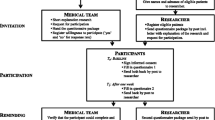Abstract
The increasing diversity of the US population has drawn attention to the need for the development of quality of life tools that are appropriate for special populations, including Hispanic Americans, Asian Pacific Islanders, and Native Americans. The Hispanics are one of the fastest growing of these special populations, and this group includes persons who have lived in the USA for many generations, as well as recent immigrants. Both language and culture are important to consider when developing a quality of life tool for Hispanics. The initial aims of this study were to develop a Spanish translation of the CAncer Rehabilitation Evaluation System (CARES), perform content and construct validation of the Spanish CARES in Spanish-speaking and bilingual patients with cancer, and provide descriptive data on the rehabilitation needs and quality of life of these patients. However, in performing this study we encountered a number of methodological problems that had not been previously described in the literature, including the need for idiomatic translations, lack of familiarity with questionnaires, low acculturation and low literacy rates among Hispanic cancer patients in the southwestern USA. We suggest a number of practical considerations for future investigators planning to develop quality of life tools for this special population.
Similar content being viewed by others
References
McDowellI, NewellG, eds. Measuring Health: A Guide to Rating Scales and Questionnaires. New York: Oxford University Press, 1987.
CroogSH, LevineS, TestaMA, et al. The effects of antihypertensive therapy on the quality of life. New Engl J Med 1986; 314: 1657–1664.
BombardierC, WareJ, RussellIJ, et al. Auranofin therapy and quality of life in patients with rheumatoid arthritis. Results of a multicenter trial. Am J Med 1986; 81: 556–578.
MoinpourCM, FeiglP, MetchB, et al. Quality of life end points in cancer clinical trials: review and recommendations. J Natl Cancer Inst 1989; 81: 485–495.
NayfieldSG, GanzPA, MoinpourCM, CellaDF, HaileyBJ. Report from a National Cancer Institute (USA) Workshop on Quality of Life Assessment in Cancer Clinical Trials. Quality Life Res 1992; 1: 203–210.
Bardelli D, Saracci R. Measuring the quality of life in cancer clinical trials. Methods and impact of controlled therapeutic trials in cancer. IUCC Technical Report Series, N. 36, 1978; 75–97.
Aaronson NeilK. Quality of life research in cancer clinical trials: a need for common rules and language. Oncology 1990; 4(5): 59–66.
SlevinML, PlantH, LynchD, DrinkwaterJ, GregoryWM. Who should measure quality of life, the doctor or the patient? Br J Cancer 1988; 57: 109–112.
PearlmanRA, UhlmannRF. Quality of life in chronic diseases: perceptions of elderly patients. J Gerontol: Med Sci 1988; 43: M25-M30.
StLegerP. Key points arising from the discussion. In: WalkerSM, RosserRM, eds. Quality of Life: Assessment and Application. Lancaster; MTP Press, 1988; 291–296.
AaronsonNK, BullingerM, AhmedzaiS. A modular approach to quality-of-life assessment in cancer clinical trials. Recent Results in Cancer Res 1988; 111: 231–249.
US Bureau of the Census, 1988.
Giachello AL. Presentation at the North American Conference on Cancer in Hispanics. Arizona Cancer Center, Tucson, 12–14 September, 1991.
MasonJO, mcGinnis. ‘Healthy People 2000’: an overview of the national health promotion and disease prevention objectives. Public Health Reports 1990, 105: 441–446.
FreemanH. Race, poverty, and cancer. J Natl Cancer Inst 1991; 83: 526–527.
Request for Applications for Research Project Grants, RFA Number CA/NR-92-97, Quality of Life Assessment in Special Populations.
BerkanovicE. The effect of inadequate language translation on Hispanics' responses to health surveys. Am J Public Health 1980; 70: 1273–1281.
ChapmanDW, CarterJF. Translation procedures for the cross cultural use of measurement instruments. Educ Eval Policy Analysis 1979; 1: 71–76.
TalbertR, HendricsonB, HudepohlN, RichardsB, McPhersonM, ReedB. Developing bilingual patient education materials: problems and solutions. J Biocommun 1981; 8: 23–28.
HendricsonWD, RussellJ, PrihodaTJ, JacobsonJM, RoganA, BishopGD. An approach to developing a valid Spanish language translation of a health-status questionnaire. Med Care 1989; 27: 959–966.
DeyoRA. Pitfalls in measuring the health status of mexican Americans: comparative validity of the English and Spanish Sickness Impact Profile. Am J Public Health 1984; 74: 569–573.
SchagCC, HeinrichRL, AadlandR, GanzPA. Assessing problems of cancer patients: psychometric properties of the Cancer Inventory of Problem Situations. Health Psychol 1990; 9: 83–102.
GanzPA, SchagCC, ChengH. Assessing the quality of life—a study in newly-diagnosed breast cancer patients. J Clin Epidemiol 1990; 43: 75–86.
GanzPA, SchagCAC, LeeJJ, SimM-S. The CARES: a generic measure of health-related quality of life for cancer patients. Quality Life Res 1992; 1: 19–29.
SchagCAC, GanzPA, HeinrichRL. Cancer Rehabilitation Evaluation System—Short Form (CARES-SF): a cancer specific rehabilitation and quality of life instrument. Cancer 1991; 68: 1406–1413.
CuellerI, HarrisLC, JassoR. An acculturation scale for Mexican American normal and clinical populations. Hispanic J Behav Sci 1980; 2: 199–217.
DeyoRA, DiehlAK, HazudaH, SternMP. A simple language-based acculturation scale for Mexican Americans: validation and application to health care research. Am J Public Health 1985; 75: 51–55.
MarinG, SabogalF, MarinBV, Otero-SabogalR, Perez-Stable. Development of a short acculturation scale for Hispanics. Hispanic J Behav Sci 1987; 9: 183–205.
AdayLA, ChinGY, AndersenR. Methodological issues in health care surveys of the Spanish heritage population. Am J Public Health 1980; 70: 367–374.
Hayes-BautistaDE. Identifying ‘Hispanic’ populations: the influence of research methodology upon public policy. Am J Public Health 1980; 70: 353–356.
SchurCL, BernsteinAB, BerkML. The importance of distinguishing subpopulations in the use of medical care. Med Care 1987; 25: 627–641.
MarinG, MarinBV. Comparison of three interviewing approaches for studying sensitive topics with Hispanics: refusal rates, interviewee discomfort, and perceived accuracy. Hispanic J Behav Sci 1989; 11: 330–334.
HowardCA, SametJM, BuechleyRW, SchragSD, KeyCR. Survey research in New Mexico Hispanics: some methodological issues. Am J Epidemiol 1983; 117: 27–34.
Author information
Authors and Affiliations
Additional information
Dr Canales was a recipient of a Fellowship from the Jonsson Comprehensive Cancer Center Foundation during the time this work was conducted.
Rights and permissions
About this article
Cite this article
Canales, S., Ganz, P.A. & Coscarelli, C.A. Translation and validation of a quality of life instrument for hispanic American cancer patients: methodological considerations. Qual Life Res 4, 3–11 (1995). https://doi.org/10.1007/BF00434377
Received:
Accepted:
Issue Date:
DOI: https://doi.org/10.1007/BF00434377




